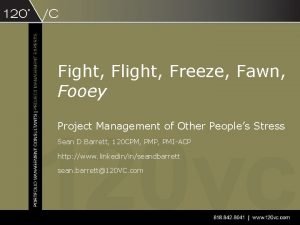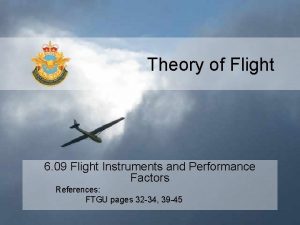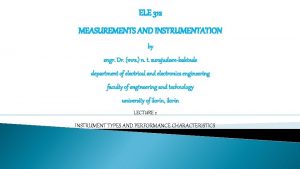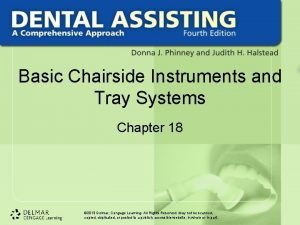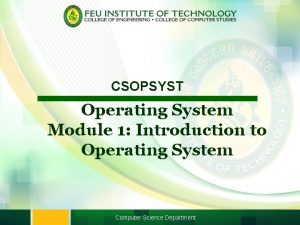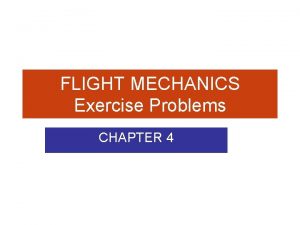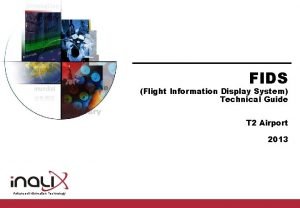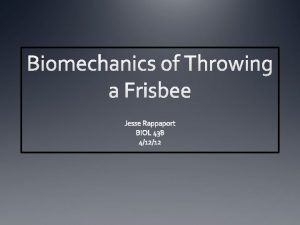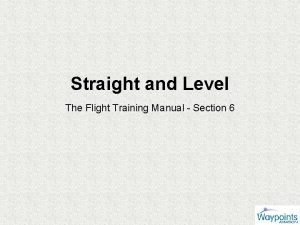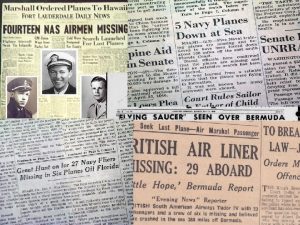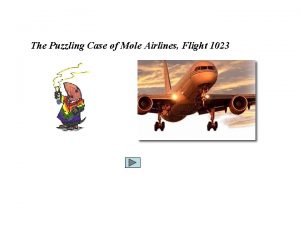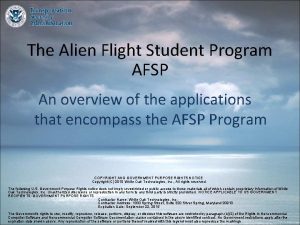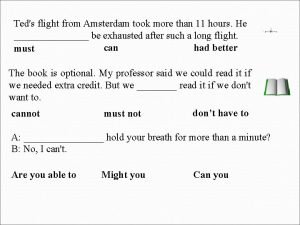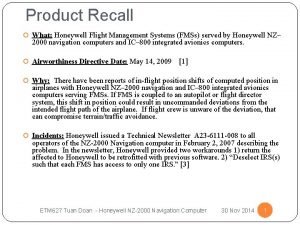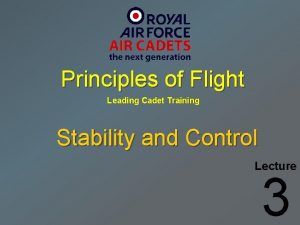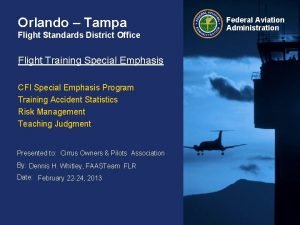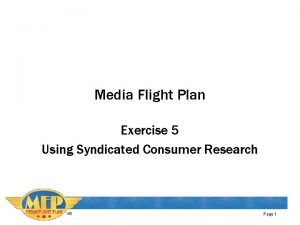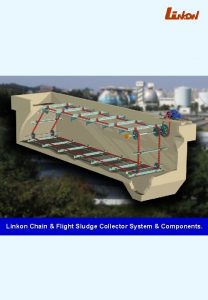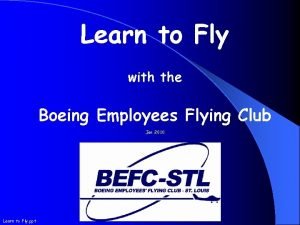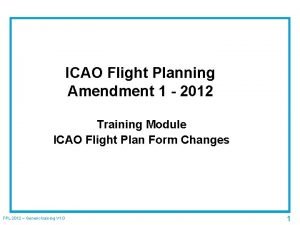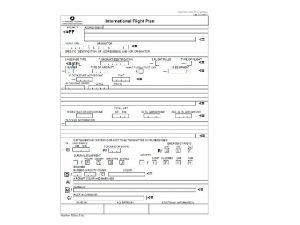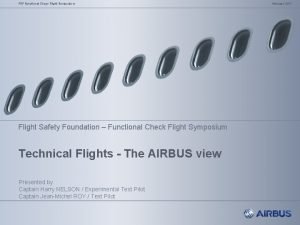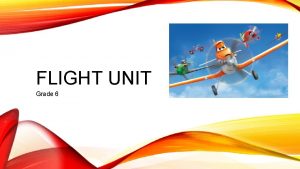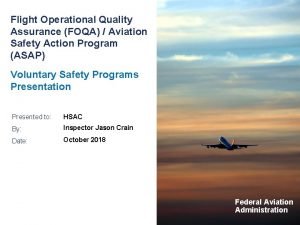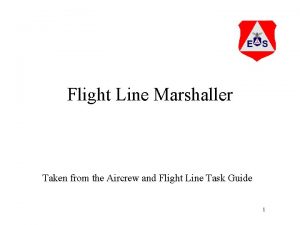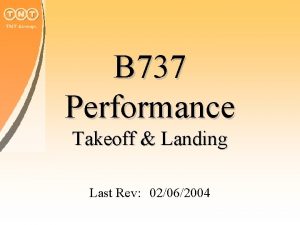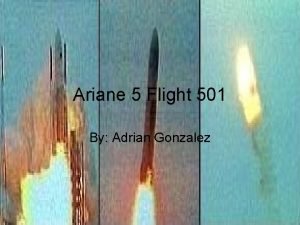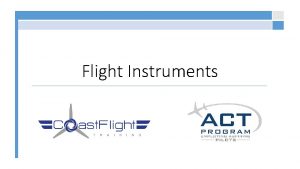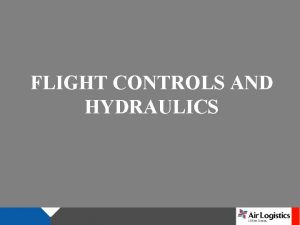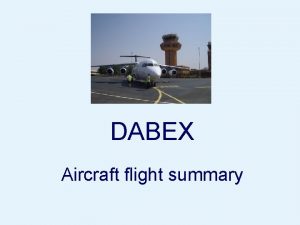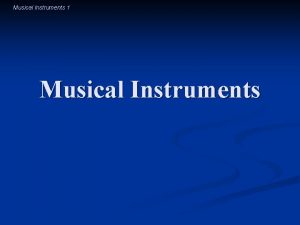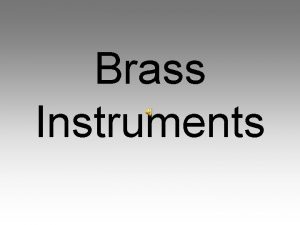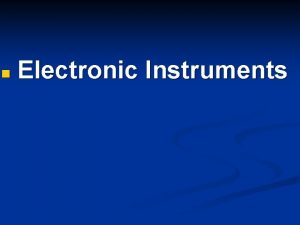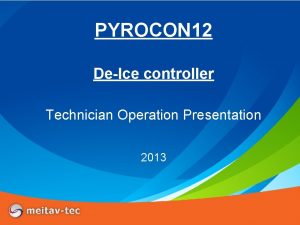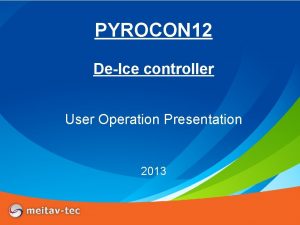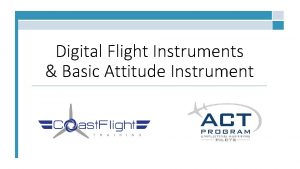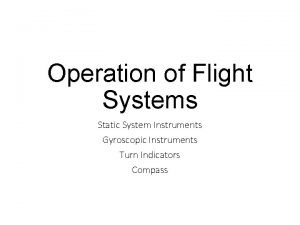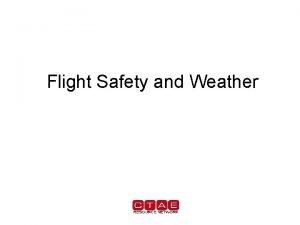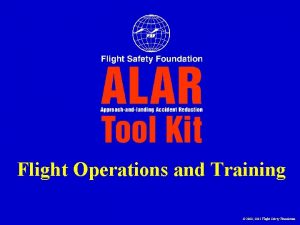Systems Flight Instruments Overview Deice and Antiice Systems

































































- Slides: 65

Systems & Flight Instruments

Overview • Deice and Anti-ice Systems • Reference Systems • Flight Instruments • Instrument Preflight © 2015 Coast Flight Training. All Rights Reserved.

Deice vs. Anti-Ice • • Deice Systems – used to remove ice after it forms Anti-ice Systems – used in advance to prevent ice from accumulating Some systems act as both Deice and Anti-ice Breakdown of Anti-ice/Deice systems • Induction • Structural (wing, pitot, windscreen, etc. ) • Propeller (if applicable) © 2015 Coast Flight Training. All Rights Reserved.

Induction Ice Control • Keeping ice out of engine air intake areas • Heated inlets on turbine engines (exhaust gas) • Carburetor heat for piston engines • Piper Archer and Piper Seminole have carburetor heat © 2015 Coast Flight Training. All Rights Reserved.

Heated Engine Inlets • Typical for turbojet and turboprop aircraft • Some hot exhaust gas or hot bleed air is routed though piping inside the engine • Hot gas flows to the front engine nacelle • The extreme heat melts or evaporates any ice on contact prior to entering the engine inlet © 2015 Coast Flight Training. All Rights Reserved.

Heated Engine Nacelle (Inlet) © 2015 Coast Flight Training. All Rights Reserved.

Carburetor Heat Systems • Simple system of changing source of intake air • Carburetor heat off: Cool air comes from outside through an air filter • Carburetor Heat On: • A pilot operated handle turns a valve to cut off direct outside air • Intake air now comes from air that has passed over the muffler shroud and been heated having *Note: Use of Carburetor heat will enrich the mixture © 2015 Coast Flight Training. All Rights Reserved.

© 2015 Coast Flight Training. All Rights Reserved.

Structural Ice Control • Ice on wings greatly reduces lift • Ice on windscreen hinders pilot vision • Ice on sensors disrupts critical instrument readings such as altitude and airspeed • Use of multiple systems • Electrical • Pneumatic • Mechanical / Fluid © 2015 Coast Flight Training. All Rights Reserved.

Wing De-Icing Boots • • • Deice only Typical for turboprop and turbo-charged piston aircraft Leading edge of wings have rubber strips Strip held flat with vacuum pressure when not in use Strip uses pressurized air to inflate into ridges • Turboprops bleed air off the compressor section • Turbocharged pistons use the turbocharger compressor • Ridges break ice off the leading edge • If too little ice, ice will form on ridges • If too much ice, boots can’t break it © 2015 Coast Flight Training. All Rights Reserved.

© 2015 Coast Flight Training. All Rights Reserved.

Wing – Hot Wing System • Used on turbojets • Very hot air is bled off of the high pressure compressor section of the jet engine • Hot air is routed through piping in the leading edge of the wind to melt existing ice or prevent buildup • The hot air is vented at some point • Can be used as anti-ice or deice © 2015 Coast Flight Training. All Rights Reserved.

© 2015 Coast Flight Training. All Rights Reserved.

Wings – Fluid System • “Weeping Wing” • Ethylene-glycol solution • Flows aft from holes near leading edge • Fluid reacts to lower freezing temperature of the aluminum metal • Prevents ice from adhering to the wing surface • Cannot work once ice accumulates • Anti-ice only © 2015 Coast Flight Training. All Rights Reserved.

© 2015 Coast Flight Training. All Rights Reserved.

Windscreen Anti-Ice • Fluid type – ethylene-glycol solution • Electric heat – element in between two layers of windshield is applied an electric current • Defroster/Defogger – use of heat from muffler shroud • Installed in Archers, Arrows and Seminoles © 2015 Coast Flight Training. All Rights Reserved.

Instrument Systems • Electrically heated ports/probes • • Pitot port, static port, pitot-mast heat Stall warning sensor heat AOA, Fuel vents and other sensors Heated pitot-mast installed in Cadets, Arrows and Seminoles © 2015 Coast Flight Training. All Rights Reserved.

Propeller Ice Control • Fluid type – ethylene-glycol • Fluid sprays from the hub • Centrifugal force carries the fluid out toward the tips • Electrically heated prop boots • Inboard leading edge (slower moving part) requires ice protection • Outboard moves too fast for ice to build • System requires a high electric load • Heating element boot is divided into two sections • Electric current alternates to these blade sections © 2015 Coast Flight Training. All Rights Reserved.

Engine Driven Vacuum System • Engine driven vacuum pump pulls air from the instrument case. • Air is drawn into the instrument from the cockpit through an air filter • Normal pressure entering the case due to suction spin the gyros as it catches the rotor vanes • Gyro speeds vary between 8000 and 18000 RPM • Some aircraft have electric backup pump © 2015 Coast Flight Training. All Rights Reserved.

Reference Systems • Standard Pressure: 29. 92 in Hg or 1013. 2 mb • Standard Temperature: 59°F or 15°C • Deviations from standard result in different reading on certain instruments © 2015 Coast Flight Training. All Rights Reserved.

Pitot-Static System • System Description • • Pitot tube Static port Drain holes Lines • Instruments • Altimeter, airspeed indicator and VSI • Must be checked every 24 months © 2015 Coast Flight Training. All Rights Reserved.

© 2015 Coast Flight Training. All Rights Reserved.

Altimeter • There is a set of aneroid wafers (capsules) inside the case sealed at 29. 92” Hg • The static line allows atmospheric pressure to enter the case (not the wafers) © 2015 Coast Flight Training. All Rights Reserved.

© 2015 Coast Flight Training. All Rights Reserved.

How the Altimeter Works • As altitude increases, static pressure decreases, thus pressure in the case decreases allowing the wafers to expand • As altitude decreases, static pressure increases thus pressure in the case increases causing the wafers to compress • The expansion/compression is linked to gears and turn the dials on the face of the instrument • The knob resets the position of the indicating needle according to altimeter setting © 2015 Coast Flight Training. All Rights Reserved.

Altimeter Error • Position error - In some installations, position error can be of considerable magnitude • Scale error - Caused by the aneroid wafers not assuming the precise size designed for a specific pressure difference • Mechanical error - Mechanical error is caused by misalignment or slippage in the gears and linkage connecting the aneroid wafers to the display © 2015 Coast Flight Training. All Rights Reserved.

Altimeter Errors • Density error - Non-standard temperatures cause an error in calculating altitude (not a problem because all react the same and vertical separation is still maintained) • Hysteresis - This error is a lag in the altitude indications caused by the elastic properties of the materials used in the aneroids. It occurs when an aircraft initiates a large, rapid altitude change or an abrupt level-off from a rapid climb or descent • Reversal error - During abrupt or rapid attitude changes, reversal error occurs; it is only momentary in duration © 2015 Coast Flight Training. All Rights Reserved.

Types of Altitude • Indicated altitude - Read off the altimeter • Pressure altitude - Height above standard datum plain • Pressure altitude = Indicated altitude when Kohlsman set to 29. 92” Hg • Density altitude - Pressure corrected for non-std temp • True altitude - Height above sea level • True altitude = Indicated altitude when Kohlsman set to current pressure setting • Absolute altitude - Height above the ground (terrain) © 2015 Coast Flight Training. All Rights Reserved.

Types of Altitude © 2015 Coast Flight Training. All Rights Reserved.

Calculating Pressure Altitude • To calculate pressure altitude: • PA = field elevation + (29. 92 – altimeter setting) x 1000 Note: Elevation refers to physical height above sea level; it can be an altitude in flight © 2015 Coast Flight Training. All Rights Reserved.

Calculating Density Altitude • To calculate Density Altitude: • DA = PA + (120 x (OAT °C– ISA temperature °C)) Note: ISA refers to the temperature it should be at the local altitude under standard temperature conditions. Example, sea level = 15°C, 6000 feet = 3°C. (use the temperature lapse rate of 2°C per 1000’ increase in altitude) © 2015 Coast Flight Training. All Rights Reserved.

Vertical Speed Indicator • The case contains a diaphragm connected directly to the static line • The case is connected to the static line through a calibrated leak © 2015 Coast Flight Training. All Rights Reserved.

How the VSI Works • Changing pressures (associated with climbs and descents) expand contract the diaphragm connected to the needle on the face • The VSI is connected to the static line through a calibrated leak • The leak allows pressure to flow in/out of the case slower than the diaphragm • This allows the VSI to measure the trend and rate of change using differential pressure © 2015 Coast Flight Training. All Rights Reserved.

VSI Errors • There is a 6 -9 second lag before getting an accurate of climb/descent • Trend is instantaneous • Instantaneous VSI (IVSI) has little or no lag © 2015 Coast Flight Training. All Rights Reserved.

Airspeed Indicator • The case contains a diaphragm connected to the pitot (ram air) line • The case is connected to the static line © 2015 Coast Flight Training. All Rights Reserved.

How the Airspeed Indicator Works • Measures difference in pressure between ram air in pitot tube inlet and atmospheric pressure from static port • The difference in pressures moves a diaphragm which links to the indicating needle on the face of the instrument © 2015 Coast Flight Training. All Rights Reserved.

Types of Airspeed • Indicated airspeed - Read directly from the indicator • Calibrated airspeed - Indicated airspeed corrected for installation / position error • Equivalent airspeed - Calibrated airspeed corrected for compressible airflow error (>10, 000 MSL and >250 kts) • True airspeed - Equivalent airspeed corrected for non-std temp and press • Groundspeed - True corrected for wind • Speed of movement across the ground – used for ETE) • Mach # - Ratio of true airspeed to local speed of sound © 2015 Coast Flight Training. All Rights Reserved.

Calculating True Airspeed • Prior to flight • Can be calculated by correcting calibrated airspeed for non-standard temperature • Cruising true airspeed can be found in charts • In-flight • Utilize scale on airspeed indicator • Align indicated altitude with ambient air temp • True airspeed indicated on the white sliding scale © 2015 Coast Flight Training. All Rights Reserved.

Pitot-Static System Erros • Pitot-tube freezes • The airspeed indicator will read zero as long as the static port is still clear • Static port freezes • Airspeed indicator will read accurately at the frozen altitude; reads higher if aircraft descends and lower if aircraft climbs • Altimeter freezes at frozen altitude • VSI indicated level © 2015 Coast Flight Training. All Rights Reserved.

Using Alternate Static Source • Prior to operation • Close all vents to cockpit and storm window • Turn on heater and defroster • Instrumentation indications • Airspeed indicator reads higher than indicated • Altimeter reads higher than normal • VSI shows a momentary climb © 2015 Coast Flight Training. All Rights Reserved.

Engine Vacuum System © 2015 Coast Flight Training. All Rights Reserved.

Gyroscopic Principles • Rigidity in space • A spinning gyroscope tends to remain aligned with its axis of rotation • Precession • When a force is applied on a rotating disc (gyroscope) it is felt 90 degrees in the direction of rotation from where it is applied © 2015 Coast Flight Training. All Rights Reserved.

Attitude Indicator • Depiction of aircraft position relative to horizon • Often called an artificial horizon • Gives instantaneous pitch and bank information • Contains a gyro with dual gimbals for movement • Display • Blue over brown indication mimics the horizon • A movable (miniature) aircraft © 2015 Coast Flight Training. All Rights Reserved.

© 2015 Coast Flight Training. All Rights Reserved.

How the Attitude Indicator Works • A gyro uses pendulous vanes to stabilize the artificial horizon to the actual horizon • Using the principle of rigidity in space, the aircraft actually pitches and bank around the gyro and is indicated by the face © 2015 Coast Flight Training. All Rights Reserved.

Attitude Indicator Limitations • Exceeding below values can cause the gyro to tumble (spin erratically) and become inaccurate • Banking more than 110 degrees • Pitching more than 70 degrees © 2015 Coast Flight Training. All Rights Reserved.

Attitude Indicator Errors • During turns the gyro tend to precess inside the gyro, leading to a false indication of a climb and turn in the other direction after completing a 180 degree turn • Accelerating causes a false climb indication • Decelerating causes a false descent indication © 2015 Coast Flight Training. All Rights Reserved.

Attitude Indicator Check • After engine start and vacuum pressure, the gyro should align with the horizon within 5 minutes • Check the vacuum pressure • If it does not align then it is likely malfunctioning • During taxi, pilots should ensure that during turns on the ground the gyro does not bank more than 5 degrees © 2015 Coast Flight Training. All Rights Reserved.

Directional Gyro • The case contains a gyro mounted on 1 gimbal for single-axis rotation • The gyro is attached to a gear that connects to the face card • A knob can adjust the face card by disconnecting the gears and turning the entire card © 2015 Coast Flight Training. All Rights Reserved.

© 2015 Coast Flight Training. All Rights Reserved.

How the Directional Gyro Works • The gyro stabilizes the indicator using between 10, 000 to 18, 000 RPM • The aircraft turns around the indicator according to the principle of rigidity in space © 2015 Coast Flight Training. All Rights Reserved.

Directional Gyro Limitations • Exceeding 55 degrees of bank or pitch may cause the gyro to tumble (spin erratically) and become inaccurate • Can be reset by momentarily caging the gyro • Do this by pulling the cage knob (if installed) and then releasing it © 2015 Coast Flight Training. All Rights Reserved.

Directional Gyro Errors • Error about 3 degrees every 15 minutes due to precession • Knowing this, the pilot should realign using the magnetic compass every 15 minutes and before attempting any holds, approaches or course tracking © 2015 Coast Flight Training. All Rights Reserved.

Horizontal Situation Indicator - HSI • Not a vacuum instrument, but related to DG • Not a gyro instrument, slaved to remote compass • Remote compass continually updates heading • It combines both the DG and the VOR/ILS display • Benefit of reducing workload and removing reverse sensing on backcourse © 2015 Coast Flight Training. All Rights Reserved.

© 2015 Coast Flight Training. All Rights Reserved.

Turn Coordinator • Electrically driven gyro • Used to determine quality of turn • Standard rate turn indicated by white lines • Contains the inclinometer (slip/skid indicator) © 2015 Coast Flight Training. All Rights Reserved.

How does the TC Work? • Uses principle of precession • Yaw from turn causes force on side of gyro • Force is translated 90 deg in direction of spin, which rolls the gyro and mini airplane or needle © 2015 Coast Flight Training. All Rights Reserved.

Turn Coordinator vs. Turn and Slip Indicator • Turn coordinator has a gyro that is canted back 30 degrees and a set of calibrated springs • This allows the TC to indicate rate-of-roll © 2015 Coast Flight Training. All Rights Reserved.

© 2015 Coast Flight Training. All Rights Reserved.

TC/TS Errors • The only real error comes when the springs wear out or get out of calibration • This would cause erroneous indications © 2015 Coast Flight Training. All Rights Reserved.

Instrument Preflight Checks • Airspeed should read zero • Altimeter reads within 75’ of field elevation with correct altimeter setting applied • Attitude indicator becomes level within 5 minutes of vacuum pressure and does not bank more than 5 degrees on the ground in turns © 2015 Coast Flight Training. All Rights Reserved.

Instrument Preflight Checks • Heading indicator does not precess more than 3 degrees every 15 minutes • Turn coordinator is level with no flags while not turning • Vertical speed indicator reads zero © 2015 Coast Flight Training. All Rights Reserved.

Instrument Taxi Check • Check that attitude indicator does not bank more than 5 degrees in a taxiing turn • Check that the heading indicator turns in the correct direction when turning © 2015 Coast Flight Training. All Rights Reserved.

Instrument Taxi Checks • The turn coordinator turns in the direction of the turn, the “ball” should swing in the opposite direction (all ground turns are skids) • The compass should be full of fluid, free floating, turn in the correct direction and indicate a known heading (check when parallel to a runway: Rwy 5 = 050 or 230 if opposite) © 2015 Coast Flight Training. All Rights Reserved.

References • Pilot’s Handbook of Aeronautical Knowledge • Instrument Flying Handbook • Instrument Procedures Handbook © 2015 Coast Flight Training. All Rights Reserved.
 Fight flight freeze fawn
Fight flight freeze fawn 6 flight instruments
6 flight instruments Cessna 172 instruments
Cessna 172 instruments Null type instrument
Null type instrument Indicating instruments and instruments with a signal output
Indicating instruments and instruments with a signal output Dental bur
Dental bur Distributed systems overview
Distributed systems overview Crtd in sap
Crtd in sap Distributed systems overview
Distributed systems overview Dual mode in os
Dual mode in os Operating systems overview
Operating systems overview Triple f gland for flight fright and fight is
Triple f gland for flight fright and fight is Consider a mach 4 airflow at a pressure of 1 atm. we wish
Consider a mach 4 airflow at a pressure of 1 atm. we wish Myths and legends of flight
Myths and legends of flight Flight information display system and open source
Flight information display system and open source Backhand frisbee
Backhand frisbee Aeroplane flight training manual
Aeroplane flight training manual Perbedaan replikasi virus dna dan rna
Perbedaan replikasi virus dna dan rna Data cleaning problems and current approaches
Data cleaning problems and current approaches Elements and their properties section 1 metals answer key
Elements and their properties section 1 metals answer key An overview of data warehousing and olap technology
An overview of data warehousing and olap technology Multicullar
Multicullar An overview of data warehousing and olap technology
An overview of data warehousing and olap technology Data quality and data cleaning an overview
Data quality and data cleaning an overview Data quality and data cleaning an overview
Data quality and data cleaning an overview Overview of storage and indexing
Overview of storage and indexing Elements and their properties section 1 metals
Elements and their properties section 1 metals Decision support systems and intelligent systems
Decision support systems and intelligent systems Tk 183 bermuda
Tk 183 bermuda Wg enloe high school
Wg enloe high school Southwest airlines flight 1248
Southwest airlines flight 1248 Weedhopper ultralight
Weedhopper ultralight The puzzling case of mole airlines flight 1023
The puzzling case of mole airlines flight 1023 Alien flight student program (afsp)
Alien flight student program (afsp) Ted's flight from
Ted's flight from Top flight parachutes
Top flight parachutes Range formula physics
Range formula physics Dx=vixt
Dx=vixt Honeywell flight management system
Honeywell flight management system Principles of flight air cadets
Principles of flight air cadets Best material for ping pong parachute
Best material for ping pong parachute Second sorrow of mary
Second sorrow of mary Tampa flight training
Tampa flight training Media flight plan exercise 8 answers
Media flight plan exercise 8 answers Flight sludge collector
Flight sludge collector Do boeing employees get flight discounts
Do boeing employees get flight discounts Kal 801
Kal 801 Cross country nav log
Cross country nav log Fpl 2012
Fpl 2012 Flights to eastern oregon
Flights to eastern oregon Southwest airlines route map
Southwest airlines route map Ats flight plan
Ats flight plan Stair construction terms
Stair construction terms Flight safety foundation
Flight safety foundation Flight training management software
Flight training management software Flight unit grade 6
Flight unit grade 6 Foqa aviation
Foqa aviation Flight management system components
Flight management system components Flight line marshaller
Flight line marshaller What factors affect projectile motion
What factors affect projectile motion Airlines language alpha bravo
Airlines language alpha bravo Flight 1677 spirit
Flight 1677 spirit Capital flight meaning
Capital flight meaning Colour 02062004
Colour 02062004 Ariane 5 flight 501
Ariane 5 flight 501 Flight path angle
Flight path angle
